Singing Syncs Up Our Heart Rate Variability
A few details from our video:
When we sing in unison, our hearts start to beat in unison. Or rather our heart rate variability or HRV syncs up with those around us.
Subscribe to ABC Science YouTube 👉 https://ab.co/2YFO4Go
This excerpt is from the Australian documentary series, Catalyst. Australians can stream the program now on ABC iview here 👉 https://ab.co/LilysLifeHacks
More about Heart Rate Variability
What's interesting is when people are singing together in a choir the heart rate variability of the various members can synchronize they all kind of go up and down together studies have shown that there are some health benefits to singing in a group.
It increases lung capacity and builds diaphragm muscles helping posture and core strength it takes concentration which makes your brain more agile and there's a real sense of joy but what feels most profound is the connectedness.
What is it about singing that makes you feel so joyful? When you're seeing the stress hormones come right down and the endorphins are up and we get the same activation in the brain is like when you're getting a reward for big part of it.
In a choir you're breathing together, you're often usually breathing deeply and when we breathe together; our heart, our brain, our lungs ;everything's working together.
To the heart of it
What's interesting is when people are singing together in a choir the heart rate variability of the various members can synchronize they all kind of go up and down together that's right so it's not the heartbeat that synchronizes but in between each heartbeat there's always little fluctuations and this is called the heart rate variability. Those variations between the beats accelerate together come down together, when everyone's connected it's remarkable. It's a curious property of our nervous system heart rate variability or HRV constantly changes in response to stress or relaxation.
HRV synchronization can reduce stress for the individual and for the group as a whole it boosts empathy trust and cooperation. In fact, it hacks the very social dynamics that make the group a success without anyone knowing.
So we're going to try to an experiment. I'm really excited to see if it's going to work this is something that we've always suspected we feel that we have a synchronization when we sing it's something that draws us to singing but we don't really know for sure so I'm hoping that there's going to be some hard data to actually back it up and prove it.
HRV synchronization is more likely in an established group, almost everyone was on solid lines. Spooky, I don't know why I didn't expect it to work, but that was remarkable. I got goosebumps both from the singing and and from the fact that you all connected and it only just hit me that I was singing “Let It Shine” and if this light just shone a it's wonderful that little light of yours.
Overall I'd say there's definitely a correlation between singing and heart rate variability it was really good, well done you're all back to flashing now I was quite surprised that it worked.
The first time but then when they all got into the groove it totally made sense they were in their right place, they were breathing together. That's amazing when they started glowing it distracted me so much because I thought how can this be working already I nearly forgot what I was supposed to be doing and I had to remember that's right I was supposed to be directing this choir not just watching their lights by enhancing the social dynamics of the group.
HRV synchronization can make us more than the sum of our parts and not just in choirs. This synchronization has been measured amongst families teams of athletes and medical workers even between people and their pets. That's a hell of a hack.
Video located by Sally Randell and Transcription edited by Claire Hewitt.
